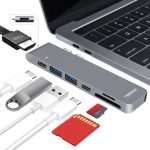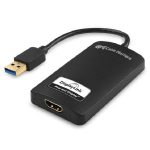In today’s tech-driven world, connecting devices seamlessly is paramount. Whether it’s streaming videos, gaming on a larger screen, or transferring files, the type of connection you choose can significantly impact your experience. Two prominent contenders in this arena are HDMI and USB-C.
This comprehensive guide aims to unravel the complexities of HDMI and USB-C, shedding light on their strengths. By the end, you’ll have a clear understanding of which port reigns supreme for your specific needs.
Contents
HDMI: The Audiovisual Powerhouse
High-Definition Multimedia Interface: A Legacy of Excellence
- HDMI has been a staple in the audiovisual world for years, renowned for its ability to transmit high-quality video.
- It’s the go-to choice for connecting TVs, monitors, gaming consoles, and Blu-ray players, delivering immersive experiences.
Strengths of HDMI
- Universal Compatibility: HDMI ports are ubiquitous, found on a vast array of devices, making it a convenient and versatile option.
- High-Bandwidth Capabilities: HDMI can handle high resolutions and refresh rates, ensuring smooth and crisp visuals for gaming and entertainment.
- Audio and Video in One: HDMI transmits both audio and video signals through a single cable, simplifying setup and reducing cable clutter.
- Established Standard: HDMI has a long history and established standards, ensuring reliability and compatibility across various devices.
Limitations of HDMI
- Bulkier Cables: Compared to USB-C, HDMI cables tend to be thicker and less flexible, potentially hindering portability and cable management.
- Limited Power Delivery: While some HDMI versions support limited power delivery, it’s not enough to charge most devices.
- Primarily Audiovisual: HDMI is primarily focused on audiovisual transmission, lacking the versatility of USB-C for data transfer and other functionalities.
USB-C: The Versatile Newcomer
USB Type-C: The Future of Connectivity
- USB-C has emerged as a game-changer, offering a compact, reversible connector and a multitude of capabilities beyond audiovisual transmission.
- It’s rapidly becoming the standard for laptops, smartphones, tablets, and even some TVs and monitors.
Strengths of USB-C
- Compact and Reversible: The USB-C connector is small, symmetrical, and reversible, eliminating the frustration of fumbling with cables.
- Multi-Purpose: USB-C supports various functions, including data transfer, video output, audio output, and power delivery, all through a single cable.
- High-Speed Data Transfer: USB-C offers blazing-fast data transfer speeds, ideal for transferring large files or connecting external hard drives.
- Power Delivery: USB-C can deliver substantial power, enough to charge laptops and other power-hungry devices.
Limitations of USB-C
- Compatibility Challenges: While adoption is growing, USB-C is not as universally compatible as HDMI, especially with older devices.
- Adapter Requirements: Connecting USB-C to HDMI or other legacy ports often requires adapters or dongles, adding complexity and potential failure.
- Confusing Standards: USB-C encompasses various standards and capabilities, making it crucial to understand the specific features supported by your devices and cables.

Choosing the Right Port: Factors to Consider
Primary Use Case
- Audiovisual Transmission: For connecting to TVs, monitors, or projectors primarily for video and audio output, HDMI remains a reliable and widely compatible option.
- Data Transfer and Charging: If you need to transfer files, connect peripherals, or charge your devices while also outputting video, USB-C’s versatility shines.
Device Compatibility
- Check Your Devices: Ensure your devices have the necessary ports. If you have a mix of HDMI and USB-C devices, you may need adapters or dongles for seamless connectivity.
- Future-Proofing: Consider future upgrades and expansions. If you anticipate acquiring devices with USB-C ports, investing in USB-C compatible displays and accessories may be beneficial in the long run.
Desired Features
- High Resolutions and Refresh Rates: For gaming or professional video editing, prioritize displays and cables that support high resolutions and refresh rates. Both HDMI and USB-C can handle these demands, but specific versions and capabilities matter.
- Audio Quality: If audio fidelity is crucial, HDMI’s dedicated audio channels offer a slight advantage over USB-C, which may rely on compressed audio formats in some cases.
- Power Delivery: If you need to charge your devices through the same cable used for video output, USB-C’s power delivery capabilities are essential.
The choice between HDMI and USB-C ultimately depends on your individual needs and priorities. HDMI remains a reliable and widely compatible option for audiovisual transmission, while USB-C offers unmatched versatility, high-speed data transfer, and power delivery.
As technology advances and USB-C adoption grows, it’s poised to become the dominant connectivity standard. However, HDMI will likely remain relevant for years to come, especially in the realm of home entertainment and legacy devices.
By understanding the strengths and limitations of each port and considering your specific requirements, you can make informed decisions and seamlessly connect your devices for an optimal experience.

Real-World Applications: HDMI vs USB-C in Action
Home Entertainment
- Connecting to TVs and Projectors: HDMI remains the dominant choice for connecting laptops, gaming consoles, and streaming devices to TVs and projectors. Its widespread compatibility and dedicated audio-video transmission ensure seamless entertainment experiences.
- Audio Systems and Soundbars: HDMI ARC (Audio Return Channel) allows for simplified audio connections between TVs and soundbars, reducing cable clutter and streamlining setup.
Productivity and Workflows
- Multi-Monitor Setups: USB-C’s ability to transmit video and data simultaneously makes it ideal for multi-monitor setups, allowing for seamless multitasking and enhanced productivity.
- Docking Stations: USB-C docking stations provide a convenient way to connect multiple peripherals, including monitors, keyboards, mice, and external storage, to a laptop through a single cable.
Mobile Devices and Peripherals
- Smartphone Connectivity: Many newer smartphones feature USB-C ports, enabling them to connect to external displays, charge other devices, and even function as desktop computers with the right accessories.
- Portable Monitors and Projectors: USB-C powered portable monitors and projectors offer a convenient and compact solution for presentations and on-the-go entertainment.
Gaming
- Next-Gen Consoles: While HDMI remains the primary connection for current gaming consoles, future generations may adopt USB-C for its versatility and potential for even higher bandwidth.
- VR Headsets: Some virtual reality headsets utilize USB-C for both video transmission and power delivery, offering a streamlined and immersive experience.
The Future Landscape: Emerging Trends and Possibilities
HDMI 2.1: Pushing the Boundaries
- The latest HDMI 2.1 specification introduces even higher bandwidth capabilities, supporting 8K resolutions, 120Hz refresh rates, and dynamic HDR, paving the way for even more immersive audiovisual experiences.
Thunderbolt 4: USB-C on Steroids
- Thunderbolt 4, built on the USB-C connector, offers unparalleled performance, supporting up to 40Gbps data transfer speeds, dual 4K display output, and up to 100W power delivery.
- It represents the pinnacle of USB-C connectivity, blurring the lines between data, video, and power transmission.
Convergence and Consolidation:
- As technology evolves, we may see further convergence and consolidation of connectivity standards.
- USB-C, with its versatility and growing adoption, has the potential to become the universal port for a wide range of devices and simplifying our lives.

Conclusion: Choosing the Right Path for Your Connectivity Needs
The HDMI vs USB-C debate highlights the ever-changing landscape of technology and connectivity. Both ports offer distinct advantages and limitations, making them suitable for different use cases.
HDMI’s legacy of excellence in audiovisual transmission and widespread compatibility make it a reliable choice for home entertainment. USB-C, with its multi-purpose capabilities, compact design, and high-speed data transfer, represents the future of connectivity, offering a streamlined and versatile solution.
Ultimately, the best choice depends on your specific needs, device compatibility, and desired features. By understanding the strengths and weaknesses of each port and considering future trends, you can make informed decisions and enjoy seamless connectivity across your devices.


